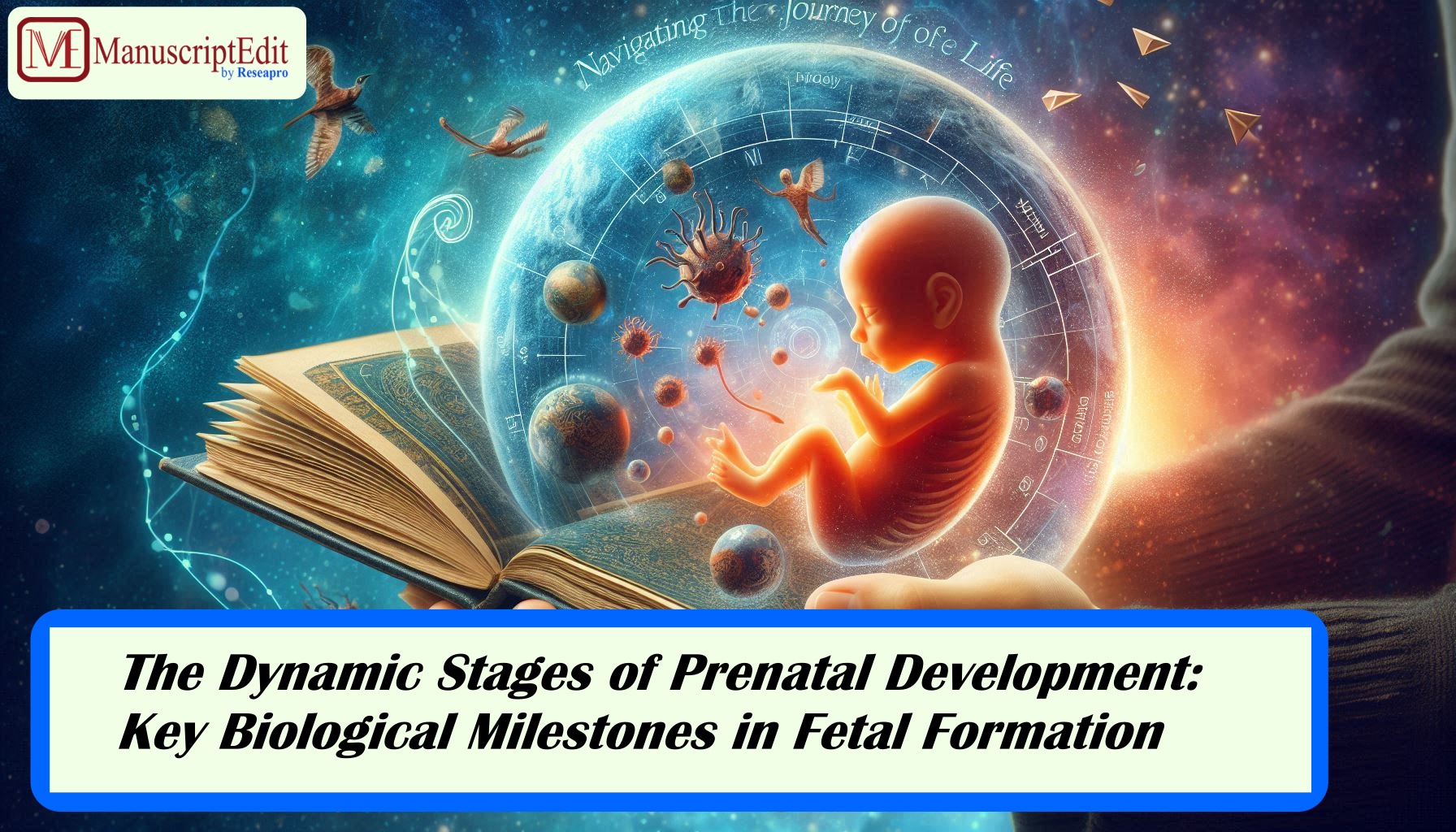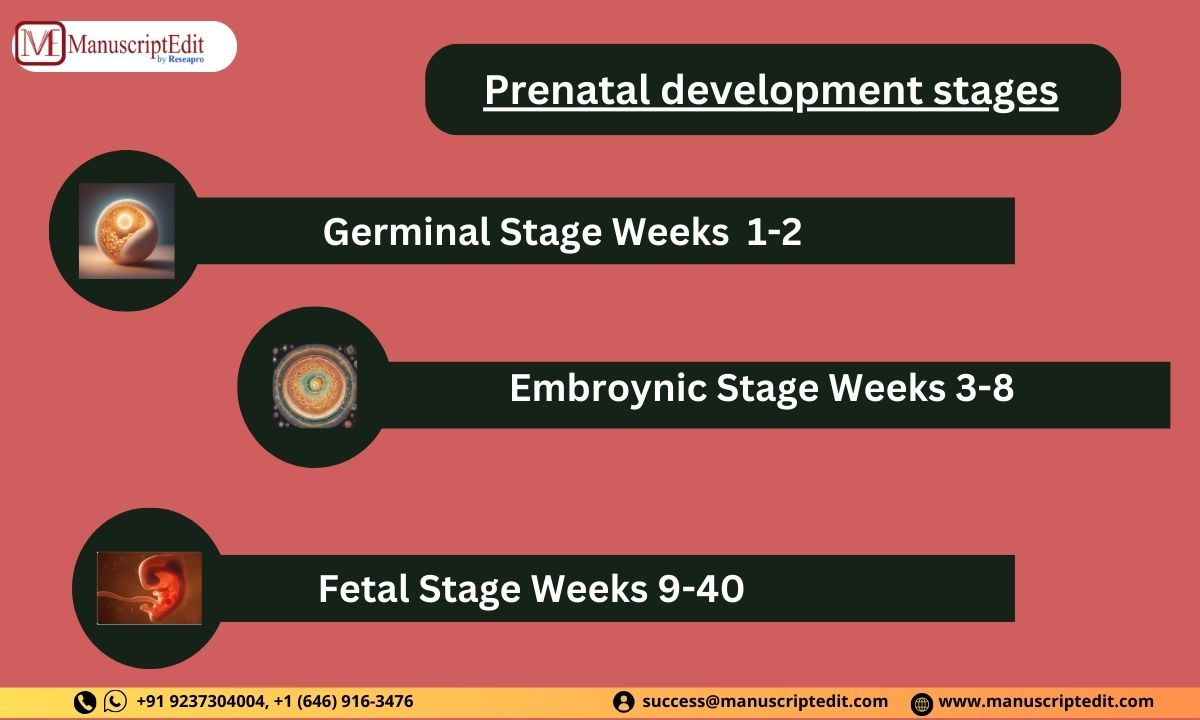|
Getting your Trinity Audio player ready...
|

Prenatal development is a dynamic, and intricate process divided into stages, each characterized by crucial biological landmarks necessary for the formation and development of a fetus. Human life begins at conception and continues through birth, yet it is characterized by a very controlled series of events, which is vulnerable and amazing at the same time. As such, this blog will take a tour through three basic types of stages in prenatal development- the germinal stage, the embryonic stage, and the fetal stage, which represent the most up-to-date scientific information, statistical data, and research about the complicated development and nature of these stages.
The Germinal Stage (Weeks 1-2): When the journey of life begins
The germinal stage, also called the zygotic stage, is the first two weeks after conception. As soon as the sperm fertilizes the egg, there now exists a single cell named the zygote. This zygote undergoes several mitotic divisions to form a blastocyst by the conclusion of the zygotic stage. It is also the time of implantation when the blastocyst attaches to the uterine wall for the necessary attachment to develop.
Key events involved in the Germinal Stage:
1. Fertilization and Initial Cell Division: From the moment of fertilization onwards, the zygote starts its initial cell divisions-cleavage-and continues to develop into a two-cell stage, followed by a four-cell stage, and so on. At this stage the blastocyst forms as the embryo enters the uterine cavity; it is comprised of an inner cell mass, a trophoblast layer, and a fluid-filled cavity.
2. Blastocyst Implantation: This stage usually occurs on the sixth day after fertilization, at which point the blastocyst attaches itself to the uterine wall. The release of human chorionic gonadotropin (hCG) results in a successful indication of pregnancy.
3. Placenta Development: By this time, placental development occurs, though it will fully start functioning in the later stages of pregnancy. It is the main interface between the mother and the fetus.
Recent research insights:
Research studies have emphasized the importance of the early stages in the regulation of genetics and epigenetics during the germinal phase. The research by Chmielewski et al. (2022) concludes that the epigenetic alterations essentially with DNA methylation patterns provided the basis for appropriate development; errors at such an early stage may cause developmental disorders or miscarriage. This is supplemented by a research article in Nature Reviews Molecular Cell Biology (2023) on how environmental stressors -for example, stress or maternal nutrition-impacts the epigenetic landscape at the germinal stage and would have consequences for later life health of the offspring.
.
Are you working on topics related to early development or genetic regulation? Let us help refine your manuscript for top Q1 and Q2 journals
Embryonic Stage (Weeks 3-8): Organogenesis and Early Development
The embryonic stage spans weeks 3 through 8. During this stage, most of the important organs and body structures will form, but the developing organism is still an embryo and endures remarkable changes as cells continue to differentiate to become fully specialized in structure and function. The time span during which these changes are happening is crucial because so much organogenesis-the formation of the basic organs of the body- actually takes place during these weeks.
Major Events of the Embryonic Stage:
1. Gastrulation: In the third week, the gastrula stage features the formation of three original germ layers: the ectoderm, the mesoderm, and the endoderm. These form all tissues and organs in the body. For example, the ectoderm is observed developing into the skin and nervous system, the mesoderm develops into muscles and the circulatory system.
2. Neurulation: Between weeks 3 and 4, the neural tube begins to develop. It is during this period that the central nervous system begins its formation. Such development marks an important milestone in human development: failure of this neurulation process results in spinal bifida or anencephaly.
3. Organogenesis: From week 8 onwards, all vital organs begin to develop: the heart, kidneys, lungs, and liver. Concerning the heart, it begins to beat around the 22nd day after fertilization; and the primitive brain begins to organize in very complex ways.
Statistical Data:
According to research from The Lancet (2023), 3% of pregnancies are marked by congenital malformations developed during embryonic growth. Heart defects are the most commonly seen. The rate of having 1 in 1000 pregnancies diagnosed with a neural tube defect is what is seen in the U.S. and accentuates the benefit of folic acid supplementation in reducing risks associated with neural tube defects.
Recent research insights:
Recent researches show that the development phase is more sensitive to environmental agents, mainly nutrition and endocrine influences. A study by Zimmerman et al. (2023) has indicated the effects of EDCs during the embryonic period on the development of organs, making permanent health disorders, metabolic syndrome or sterility, for example.
The Fetal Period (Weeks 9 – 38): Growth and Maturation
The longest final stage of development is the fetal stage, continuing from week 9 through birth. In this stage, the organism, now called a fetus, rapidly grows, body systems mature, and it prepares for life outside its mother’s womb. The fetal stage is marked by rapid growth and maturation of vital organs and systems.
Key events involved in the fetal stage:
1. Growth and Size Increase: The size of the fetus continues to increase exponentially during the fetal stage. During the start of this stage, the fetus is nearly the size of a grape, at about 2.5 cm; in comparison, at its end, it averages 50 cm in length and weighs about 3.5 kg.
2. Maturation of Organ Systems: Although most of the organ systems have started to develop in the embryonic stage, it is during the fetal stage that organ functionality is refined. For example, the lungs mature significantly in the fetal stage; surfactants start to be developed in it, beginning at around 24 weeks of gestation and play an important role after birth in breathing. The kidneys start producing urine into the amniotic fluid and the digestive system starts to function; the fetus swallows and digests the amniotic fluid.
3. Brain Development: A significant proportion of fetal development is dedicated to brain maturation. Between weeks 9 and birth, the fetal brain increases from approximately 50 grams to an estimated 400 grams. This period is particularly crucial for neural wiring and synaptic development.
4. Sensory Development and Motor Activities : It is around the 20th week that the fetus displays primitive forms of senses; the fetus can identify some environment from the outside, such as light and sound. Movements: The fetus movements such as kicks, stretch, and suckle, can be seen prominently from the 16th week onwards.
According to research, more than 90% of fetal development happens during the second and third trimesters. By 24 weeks gestation, the fetus has achieved a level of development such that, if premature, may survive outside the uterus at 50%, and this rate continues to rise with each passing week of gestation. Babies born preterm at 28 weeks are able to survive at a rate of 90%, according to advances in neonatal care (American Journal of Obstetrics and Gynecology, 2023).

Conclusion: The Unfolding Journey of Life
Prenatal development is a very complex procedure characterized by specific and tightly regulated stages: germinal, embryonic, and fetal. From the fertilizing of the egg at the beginning to the last weeks before birth, every stage plays a critical role in determining the state of health and development the individual will have from then onwards. The better we understand this process, the more we can strive to enhance the care and intervene in developmental disruption cases. Therefore, the promising future of our ability to protect the health of generations was felt as both possible and near at hand in the most recent research and new technologies, particularly genomics, epigenetics, and prenatal diagnostics.
This now puts these stages into the very interesting area of research that presents an opportunity to add to the ever-growing literature aimed at optimizing prenatal health, minimizing risks, and ultimately the outcomes for both mother and child.



